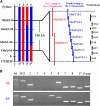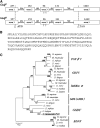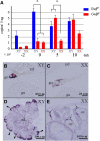Tracing the emergence of a novel sex-determining gene in medaka, Oryzias luzonensis
- PMID: 22367037
- PMCID: PMC3338257
- DOI: 10.1534/genetics.111.137497
Tracing the emergence of a novel sex-determining gene in medaka, Oryzias luzonensis
Abstract
Three sex-determining (SD) genes, SRY (mammals), Dmy (medaka), and DM-W (Xenopus laevis), have been identified to date in vertebrates. However, how and why a new sex-determining gene appears remains unknown, as do the switching mechanisms of the master sex-determining gene. Here, we used positional cloning to search for the sex-determining gene in Oryzias luzonensis and found that GsdfY (gonadal soma derived growth factor on the Y chromosome) has replaced Dmy as the master sex-determining gene in this species. We found that GsdfY showed high expression specifically in males during sex differentiation. Furthermore, the presence of a genomic fragment that included GsdfY converts XX individuals into fertile XX males. Luciferase assays demonstrated that the upstream sequence of GsdfY contributes to the male-specific high expression. Gsdf is downstream of Dmy in the sex-determining cascade of O. latipes, suggesting that emergence of the Dmy-independent Gsdf allele led to the appearance of this novel sex-determining gene in O. luzonensis.
Figures





Similar articles
-
Dmy initiates masculinity by altering Gsdf/Sox9a2/Rspo1 expression in medaka (Oryzias latipes).Sci Rep. 2016 Jan 25;6:19480. doi: 10.1038/srep19480. Sci Rep. 2016. PMID: 26806354 Free PMC article.
-
Evidence for different origins of sex chromosomes in closely related Oryzias fishes: substitution of the master sex-determining gene.Genetics. 2007 Dec;177(4):2075-81. doi: 10.1534/genetics.107.075598. Epub 2007 Oct 18. Genetics. 2007. PMID: 17947439 Free PMC article.
-
Field survey of sex-reversals in the medaka, Oryzias latipes: genotypic sexing of wild populations.Zoolog Sci. 2004 Jun;21(6):613-9. doi: 10.2108/zsj.21.613. Zoolog Sci. 2004. PMID: 15226583
-
Evolution of the sex-determining gene in the teleostean genus Oryzias.Gen Comp Endocrinol. 2016 Dec 1;239:80-88. doi: 10.1016/j.ygcen.2015.10.004. Epub 2015 Oct 9. Gen Comp Endocrinol. 2016. PMID: 26449160 Review.
-
Sex determination and sex chromosome evolution in the medaka, Oryzias latipes, and the platyfish, Xiphophorus maculatus.Cytogenet Genome Res. 2002;99(1-4):170-7. doi: 10.1159/000071590. Cytogenet Genome Res. 2002. PMID: 12900561 Review.
Cited by
-
Sex chromosome turnover in hybridizing stickleback lineages.Evol Lett. 2024 May 11;8(5):658-668. doi: 10.1093/evlett/qrae019. eCollection 2024 Sep. Evol Lett. 2024. PMID: 39328282 Free PMC article.
-
Whole-Genome Re-sequencing and Transcriptome Reveal Oogenesis-Related Genes in Autotetraploid Carassius auratus.Mar Biotechnol (NY). 2021 Apr;23(2):233-241. doi: 10.1007/s10126-021-10018-7. Epub 2021 Mar 6. Mar Biotechnol (NY). 2021. PMID: 33675430
-
A PCR assay detects a male-specific duplicated copy of Anti-Müllerian hormone (amh) in the lingcod (Ophiodon elongatus).BMC Res Notes. 2016 Apr 22;9:230. doi: 10.1186/s13104-016-2030-6. BMC Res Notes. 2016. PMID: 27103037 Free PMC article.
-
Genome Sequence of the Euryhaline Javafish Medaka, Oryzias javanicus: A Small Aquarium Fish Model for Studies on Adaptation to Salinity.G3 (Bethesda). 2020 Mar 5;10(3):907-915. doi: 10.1534/g3.119.400725. G3 (Bethesda). 2020. PMID: 31988161 Free PMC article.
-
Gene expression analysis at the onset of sex differentiation in turbot (Scophthalmus maximus).BMC Genomics. 2015 Nov 18;16:973. doi: 10.1186/s12864-015-2142-8. BMC Genomics. 2015. PMID: 26581195 Free PMC article.
References
-
- Arnold C., Hodgson I. J., 1991. Vectorette PCR: a novel approach to genomic walking. Genome Res. 1: 39–42. - PubMed
-
- Devlin R. H., Nagahama Y., 2002. Sex determination and sex differentiation in fish: an overview of genetic, physiological, and environmental influences. Aquaculture 208: 191–364.
-
- Formacion M. J., Uwa H., 1985. Cytogenetic studies on the origin and species differentiation of the Philippine medaka, Oryzias luzonensis. J. Fish Biol. 27: 285–291.
-
- Foster J. W., Brennan F. E., Hampikian G. K., Goodfellow P. N., Sinclair A. H., et al. , 1992. Evolution of sex determination and the Y chromosome: SRY-related sequences in marsupials. Nature 359: 531–533. - PubMed
-
- Gautier A., Sohm F., Joly J. S., Le Gac F., Lareyre J. J., 2011. The proximal promoter region of the zebrafish gsdf gene is sufficient to mimic the spatio-temporal pattern of the endogenous gene in Sertoli and granulosa cells. Biol. Reprod. 85: 1240–1251. - PubMed
Publication types
MeSH terms
Substances
LinkOut - more resources
Full Text Sources
Other Literature Sources
Research Materials

